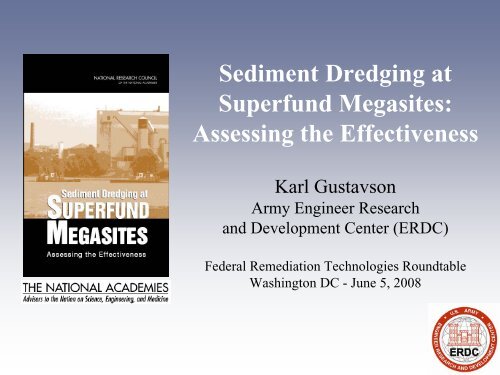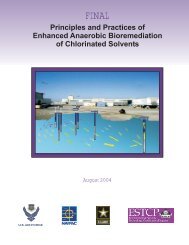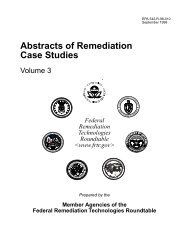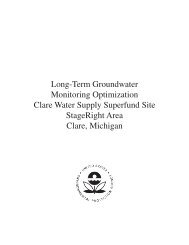Sediment Dredging at Superfund Megasites ... - Emsus.com
Sediment Dredging at Superfund Megasites ... - Emsus.com
Sediment Dredging at Superfund Megasites ... - Emsus.com
You also want an ePaper? Increase the reach of your titles
YUMPU automatically turns print PDFs into web optimized ePapers that Google loves.
<strong>Sediment</strong> <strong>Dredging</strong> <strong>at</strong><strong>Superfund</strong> <strong>Megasites</strong>:Assessing the EffectivenessKarl GustavsonArmy Engineer Researchand Development Center (ERDC)Federal Remedi<strong>at</strong>ion Technologies RoundtableWashington DC - June 5, 2008
Committee Membership• Charles R. O’Melia (Chair),Johns Hopkins University• G. Allen Burton, Wright St<strong>at</strong>eUniversity• William H. Clements,Colorado St<strong>at</strong>e University• Frank C. Curriero, JohnsHopkins Bloomberg School ofPublic Health• Dominic Di Toro, University ofDelaware• Norman R. Francingues, OASystems Corpor<strong>at</strong>ion• Richard G. Luthy, StanfordUniversity• Perry L. McCarty, StanfordUniversity• Nancy Musgrove,Management of EnvironmentalResources, Inc.• K<strong>at</strong>herine N. Probst,Resources for the Future• Danny D. Reible, University ofTexas• Louis J. Thibodeaux,Louisiana St<strong>at</strong>e University• Donna J. Vorhees, TheScience Collabor<strong>at</strong>ive• John R. Wolfe, Limno-Tech,Inc.
Reviewers of the Final ReportReview Referees• George M. HornbergerUniversity of Virginia• C. Herb Ward, Rice UniversityReviewers• Todd S. Bridges, U.S. ArmyEngineer Research andDevelopment Center• Edwin H. Clark II, Earth PolicyInstitute• J. Paul Doody, BBL-Arcadis• Rick Fox, N<strong>at</strong>ural ResourceTechnology, Inc.• Paul Fuglevand Dalton,Olmsted & Fuglevand, Inc.• John C. HenningsonHenningson EnvironmentalServices• Chris Ingersoll, U.S. GeologicalSurvey• Stephen U. Lester, Center forHealth & Environmental Justice• Jeffrey S. Levinton, StonyBrook University• Victor S. Magar, ENVIRON• Larry McShea, Alcoa• Steven C. Nadeau, HonigmanMiller Schwartz and Cohn, LLP.• Clay P<strong>at</strong>mont, AnchorEnvironmental, LLC.• Harlee S. Strauss, H. StraussAssoci<strong>at</strong>es, Inc.
St<strong>at</strong>ement of TaskEvalu<strong>at</strong>e the expected effectiveness of sediment dredgingin achieving risk reduction <strong>at</strong> <strong>Superfund</strong> megasites.The <strong>com</strong>mittee was charged to consider:• Short and long-term effects on ecologic<strong>com</strong>munities• Site specific factors th<strong>at</strong> contribute to or hindereffectiveness• Whether current monitoring technologies aresufficient and how they can be improved• How to improve sediment megasite decisionmakingin the future.
Outline• Introduction• Evalu<strong>at</strong>ion of <strong>Dredging</strong> Effectiveness• Monitoring <strong>at</strong> <strong>Sediment</strong> <strong>Megasites</strong>• Improving Future Decision-Making
Risk-based Decision-Making•Risk rel<strong>at</strong>es to exposures tocontaminants above acceptablelevels.•Remedi<strong>at</strong>ion should be designed toelimin<strong>at</strong>e or reduce those exposures.•Exposures are dict<strong>at</strong>ed by surfacesediments – contaminants buriedbelow the biologically-active zone arenot available to organisms.•Disrupting sediment beds to removeburied contaminants can exposeorganisms to otherwise inaccessiblecontaminants.•However, removal of deeply buriedcontaminants may thwart futureexposure and transport during severeevents.Historical changes in sediment core profilesof mercury concentr<strong>at</strong>ions in BellinghamBay, WA. Source: P<strong>at</strong>mont et al. 2004.
Committee’s Evalu<strong>at</strong>ion of<strong>Dredging</strong> Sites• The <strong>com</strong>mittee examined experiences <strong>at</strong> 26 dredgingprojects and evalu<strong>at</strong>ed whether, after dredging, thecleanup goals had been met.-Had a site achieved its quantit<strong>at</strong>ive cleanup levels (typically aspecified contaminant concentr<strong>at</strong>ion in sediment).-Had a site achieved its remedial-action objectives (wh<strong>at</strong> thecleanup is expected to ac<strong>com</strong>plish in the long term).-Factors th<strong>at</strong> contributed to the success or adversely affecteddredging oper<strong>at</strong>ions.• Various sites were examined, including full-scaledredging projects, pilot studies <strong>at</strong> sites, and dredgingprojects within a large-scale remedi<strong>at</strong>ion effort.
26 Environmental-<strong>Dredging</strong> ProjectsSelected for Evalu<strong>at</strong>ion• Bayou Bonfouca LA• Lavaca Bay, TX• Black River, OH• Outboard Marine Corpor<strong>at</strong>ion– Waukegan Harbor, IL• Commencement Bay–Head ofHylebos, Ta<strong>com</strong>a, WA• Commencement Bay–Sitcum,Ta<strong>com</strong>a, WA• Duwamish Diagonal, Se<strong>at</strong>tle,WA• Puget Sound Naval Shipyard,Bremerton, WA• Harbor Island–Lockheed,Se<strong>at</strong>tle, WA• Harbor Island–Todd, Se<strong>at</strong>tle,WA• Cumberland Bay, NY• Dupont–Christina River, DE• Lower Fox River (OU-1), WI• Lower Fox River (Deposit N), WI• Lower Fox River (SMU 56/57), WI• Ketchikan Pulp Company, WardCove, AK• Newport Naval Complex–McCallister Landfill, RI• GM Central Foundry, St. LawrenceRiver, NY• Grasse River, NY (non-time-criticalremoval action)• Grasse River, NY remedial optionspilot study (ROPS)• Lake Jarnsjon, SwedenManistique Harbor, MI• Reynolds Metals, St. LawrenceRiver, NY• Mar<strong>at</strong>hon B<strong>at</strong>tery, Hudson River,Cold Spring, NY• New Bedford Harbor, MA (hotspot)• United Heck<strong>at</strong>horn, Richmond, CA
Evalu<strong>at</strong>ion of <strong>Dredging</strong> Effectiveness• Oper<strong>at</strong>ional goals (mass removal or dredging toelev<strong>at</strong>ion) were achieved <strong>at</strong> many sites.• <strong>Dredging</strong> is effective <strong>at</strong> removing large volumes ofcontamin<strong>at</strong>ed sediments from the environment.– This doesn’t necessarily equ<strong>at</strong>e to risk reduction, but can beuseful if those sediments are likely to be transported to lesscontamin<strong>at</strong>ed areas.• <strong>Dredging</strong> alone achieved desired contaminant-specificcleanup levels <strong>at</strong> only a few of the reviewed sites.– Capping after dredging was often necessary to achieve cleanuplevels.• At some sites, dredging achieved cleanup levels andpresumably contributed to declines in biota contaminantconcentr<strong>at</strong>ions.
Evalu<strong>at</strong>ion of <strong>Dredging</strong> EffectivenessDifficulties achieving low postdredgingsurface sedimentcontaminant concentr<strong>at</strong>ionsarise primarily from:• dredging’s limit<strong>at</strong>ions in fullyremoving contamin<strong>at</strong>edsediments.Courtesy of Marc Mills, US EPA - ORD
Evalu<strong>at</strong>ion of <strong>Dredging</strong> EffectivenessDifficulties achieving low postdredgingsurface sedimentcontaminant concentr<strong>at</strong>ionsarise primarily from:• site conditions th<strong>at</strong> limit<strong>com</strong>plete removal ofcontamin<strong>at</strong>ed sediments.The result is residualcontamin<strong>at</strong>ion th<strong>at</strong> hindersthe ability to achieve riskreduction.(Dalton, Olmsted & Fuglevand, Inc. 2006)
Evalu<strong>at</strong>ion of <strong>Dredging</strong> Effectiveness• <strong>Dredging</strong> can cause releases of contaminants duringoper<strong>at</strong>ions th<strong>at</strong> increase w<strong>at</strong>er column and fish tissuecontaminant concentr<strong>at</strong>ions in the short term.(NRC 2007; d<strong>at</strong>a from Alcoa 2006)
Evalu<strong>at</strong>ion of <strong>Dredging</strong> Effectiveness• The longer-term benefits to human health and the environment ofdredging contamin<strong>at</strong>ed sediments are not well understood ordocumented.– Monitoring <strong>at</strong> most sites does not include the full array ofmeasures necessary to evalu<strong>at</strong>e risk.– <strong>Dredging</strong> may have occurred in conjunction with otherremedies or n<strong>at</strong>ural processes.– Insufficient time may have passed to evalu<strong>at</strong>e long-term riskreduction.• Due to these deficiencies, the <strong>com</strong>mittee was generally unable toestablish whether dredging alone is capable of achieving longtermrisk reduction.
So, Does <strong>Dredging</strong> Work or Not?• There is not a single answer to thisquestion.• Results will be site specific and depend onsite conditions, the adequacy of predredgingcharacteriz<strong>at</strong>ion of thoseconditions, and the implement<strong>at</strong>ion of theremedial action.• For example…14
Range of Experiences <strong>at</strong> <strong>Dredging</strong> ProjectsGrasse River, NY• Removed 24,600 cy in 2005.• Average surficial sediment PCBconcentr<strong>at</strong>ions increased afterdredging from 4.1 mg/kg to 150mg/kg. No cleanup level.• Intended to remove 64,000 cy; Ableto dredge 40% of the targeted area.Capped entire dredged areafollowing remedi<strong>at</strong>ion.• Residuals: Average of 16 in. ofcontamin<strong>at</strong>ed sediments remainedafter dredging (range from 3 to 32in.)• Increased contaminantconcentr<strong>at</strong>ions in fish and w<strong>at</strong>erduring dredgingHead of Hylebos, WA• Removed 404,000 cy from 2004 to2006.• Average surficial sediment PCBconcentr<strong>at</strong>ions decreased afterdredging from 0.69 mg/kg to 0.07mg/kg. Cleanup level: 0.3 mg/kg.• <strong>Sediment</strong>s from targeted areas weresuccessfully dredged. Had to cap onearea due to remaining contamin<strong>at</strong>ion.• Residuals: No summary st<strong>at</strong>istics;Ranged from 0 to >12 in. Residualcontamin<strong>at</strong>ed sediments were belowcleanup level.• No sampling for contaminantconcentr<strong>at</strong>ions in w<strong>at</strong>er and in fish.15
Differences in Site Conditions Influence ResultsGrasse River, NY• Contamin<strong>at</strong>ed sedimentsunderlain by bedrock and hardpan(not “dredgeable”).• River channel deepened byblasting contains unevensubstr<strong>at</strong>e (ridges, gulleys,sc<strong>at</strong>tered boulders) bene<strong>at</strong>hsediments th<strong>at</strong> make dredgeaccess difficult.• Difficult to characterize the depthof contamin<strong>at</strong>ed sediment usingstandard characteriz<strong>at</strong>iontechniques due to heterogeneity ofunderlying m<strong>at</strong>erial.• Debris present; removed prior todredging oper<strong>at</strong>ions.Head of Hylebos, WA• Contamin<strong>at</strong>ed sediments underlain bydense, sandy m<strong>at</strong>erial (“dredgeable”).• Former tidal fl<strong>at</strong> has rel<strong>at</strong>ivelyfe<strong>at</strong>ureless and homogeneoussubstr<strong>at</strong>e underlying contamin<strong>at</strong>edsediments.• Rel<strong>at</strong>ively easy to characterize thedepth and extent of contamin<strong>at</strong>ionbased on historic channel depth andvisual differences betweencontamin<strong>at</strong>ed and clean sediment.• Debris present; removed prior todredging oper<strong>at</strong>ions.16
Manistique River and Harbor•Removal was initially expected totake 3 seasons and remove 104,000cy – project took 6 seasons andremoved approxim<strong>at</strong>ely 190,000 cy.•Issues encountered in characterizingthe extent of contamin<strong>at</strong>ed sedimentand <strong>com</strong>pletely removing sedimentresiding over fractured bedrock.•Cleanup level: average PCBconcentr<strong>at</strong>ion of 10 mg/kg throughoutthe sediment column within the AOC.•Post-dredging average PCBconcentr<strong>at</strong>ions (top foot) throughoutthe site were 9.0 mg/kg (2000) and7.3 mg/kg (2001).
Manistique River and HarborPost-dredging <strong>Sediment</strong><strong>at</strong>ion•Following cess<strong>at</strong>ion of dredging in2000, there has been substantialsediment<strong>at</strong>ion in the harbor.•Upwards of 83,000 cubic yardswere deposited in the harbor; insome places up to 5 meters thick.•This has buried residual PCBs; in2004 surface sediment averageconcentr<strong>at</strong>ion was 0.88 mg/kg.•Indic<strong>at</strong>es the potential importanceof other processes in <strong>com</strong>b<strong>at</strong>ingresidual contamin<strong>at</strong>ion andachieving risk reduction.
Evalu<strong>at</strong>ion of <strong>Dredging</strong> EffectivenessRECOMMENDATIONS:• Remedies should be designed to meet long-term riskreductiongoals (as opposed to metrics not strictly rel<strong>at</strong>ed torisk, such as mass-removal targets).• Environmental conditions th<strong>at</strong> limit or favor the effectivenessof dredging should be given major consider<strong>at</strong>ion in decidingwhether to dredge <strong>at</strong> a site.• Resuspension, release, and residuals will occur if dredging isperformed. Decision-making should explicitly consider thoseprocesses in expect<strong>at</strong>ions of risk reduction.• To reduce adverse effects, best-management practices th<strong>at</strong>limit resuspension and residual contamin<strong>at</strong>ion should be usedduring dredging. The ability of <strong>com</strong>bin<strong>at</strong>ion remedies tolessen the adverse effect of residuals should be considered.
Monitoring for EffectivenessCurrent monitoring techniques are generally adequ<strong>at</strong>e for describingrisk. However, they have not been adequ<strong>at</strong>ely applied <strong>at</strong> many<strong>Superfund</strong> sites to describe whether long-term risk reductionobjectives have been achieved.– Sparse or in<strong>com</strong>plete monitoring d<strong>at</strong>a were collected.– Selected organisms were not linked to remedi<strong>at</strong>ion <strong>at</strong> the site.– Preremedi<strong>at</strong>ion monitoring approaches were not consistentwith those used for long-term postremedi<strong>at</strong>ion monitoring.– Pre-remedi<strong>at</strong>ion trends were not of sufficient dur<strong>at</strong>ion to enablejudging the effect of the remedial action.– Monitoring was of insufficient quality or quantity to supportrigorous st<strong>at</strong>istical analyses.
Monitoring <strong>at</strong> <strong>Sediment</strong> <strong>Megasites</strong>RECOMMENDATIONS:We need to do a better job evalu<strong>at</strong>ing the effectiveness of remedialactions <strong>at</strong> <strong>Superfund</strong> sites.• EPA should ensure th<strong>at</strong> monitoring is conducted <strong>at</strong> all contamin<strong>at</strong>edsediment megasites to evalu<strong>at</strong>e remedy effectiveness.• Descriptions of risk reduction require:– A pre-remedial baseline d<strong>at</strong>a set for <strong>com</strong>parison to post-remedi<strong>at</strong>iond<strong>at</strong>a– Appropri<strong>at</strong>e controls and reference sites– Consistent sampling and appropri<strong>at</strong>e st<strong>at</strong>istical power.• Monitoring d<strong>at</strong>a should be <strong>com</strong>piled and made publicly availablesuch th<strong>at</strong> it’s possible to verify evalu<strong>at</strong>ions of remedial efficacyindependently.
Improving Future Decision-Making• The large sp<strong>at</strong>ial scale and long remedial timeframes ofcontamin<strong>at</strong>ed sediment megasites make it difficult topredict and quantify the human health and ecosystemrisk-reduction benefits achieved by isol<strong>at</strong>ed remedi<strong>at</strong>ionsin a large-scale w<strong>at</strong>ershed.• The <strong>com</strong>plexity and heterogeneity of large-scalemegasites suggest th<strong>at</strong> a variety and <strong>com</strong>bin<strong>at</strong>ion ofremedial approaches will often be appropri<strong>at</strong>e.• The <strong>com</strong>mittee’s retrospective analysis on ‘wh<strong>at</strong> worksand why’ in sediment remedi<strong>at</strong>ion is an essential part ofa shared experience among regul<strong>at</strong>ors, practitioners,and the public. This type of effort needs to be ongoing.
Improving Future Decision-Making• An adaptive-management approach is essential to the selectionand implement<strong>at</strong>ion of remedies <strong>at</strong> contamin<strong>at</strong>ed-sedimentmegasites where there is a high degree of uncertainty about theeffectiveness of dredging.This approach:– replaces the paradigm of establishing all remedial actionsprior to implement<strong>at</strong>ion.– focuses on achieving objectives during a specified timeframe.– is based on the use of monitoring d<strong>at</strong>a from pilot studies andongoing remedi<strong>at</strong>ion.– uses d<strong>at</strong>a collected during remedial oper<strong>at</strong>ions to assess andimprove remedies to optimize progress towards remedialgoals.










